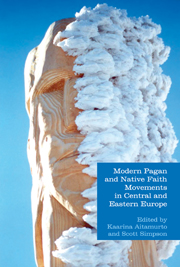Book contents
- Frontmatter
- Contents
- Contributors
- 1 Introduction: Modern Pagan and Native Faith Movements in Central and Eastern Europe
- Part I Overviews
- Part I Country Studies
- Part III Thematic Studies
- 18 The Ideology of Jan Stachniuk and the Power of Creation
- 19 “Imported” Paganisms in Poland in the Twenty-First Century: A Sketch of the Developing Landscape
- 20 The Russian-Language Internet and Rodnoverie
- Bibliography
- Index
20 - The Russian-Language Internet and Rodnoverie
from Part III - Thematic Studies
- Frontmatter
- Contents
- Contributors
- 1 Introduction: Modern Pagan and Native Faith Movements in Central and Eastern Europe
- Part I Overviews
- Part I Country Studies
- Part III Thematic Studies
- 18 The Ideology of Jan Stachniuk and the Power of Creation
- 19 “Imported” Paganisms in Poland in the Twenty-First Century: A Sketch of the Developing Landscape
- 20 The Russian-Language Internet and Rodnoverie
- Bibliography
- Index
Summary
INTRODUCTION
In the late 1980s and early 1990s with the end of the totalitarian system and the emergence of freedom of speech in Russia, people (especially young people) got the opportunity to communicate freely with each other for the first time. Technology often enabled this communication, such as the Efir (“Ether”) or Leningrad Telephone Air chat rooms of the 1980s (when callers dialed a certain secret telephone number, they could interact collectively). There, various issues were discussed, including Pagan-related topics like the historical re-enactment and role-playing movement (originally, largely inspired by the books of J. R. R. Tolkien in the USSR). FidoNet (a BBS system for PCs with modems) became widely available after 1990 and carried similar topics. Nevertheless, as some participants later explained “Nothing there was serious.” By the mid-1990s, the “Runet” (that is, the Russian-language segment of the Internet) had spread to cover an increasing number of people in the former USSR. In 1996, the first Pagan-dedicated website on Runet appeared. It involved Vadim Kazakov, who at that time left the Moscow Slavic Pagan community and organized the SSO (Union of Slavic Communities).
Today, Rodnover Runet resources include not only followers from Russia, but also the Russian-speaking population of the former USSR and other 2011 the Russian Federation ranked first in the number of Internet users in Europe.
- Type
- Chapter
- Information
- Publisher: Acumen PublishingPrint publication year: 2013



